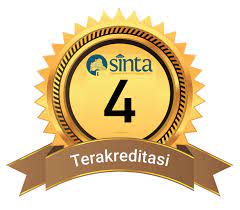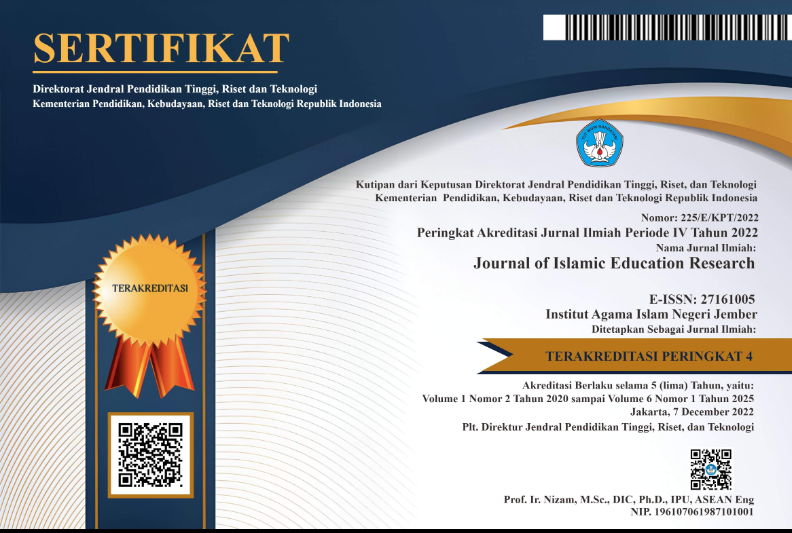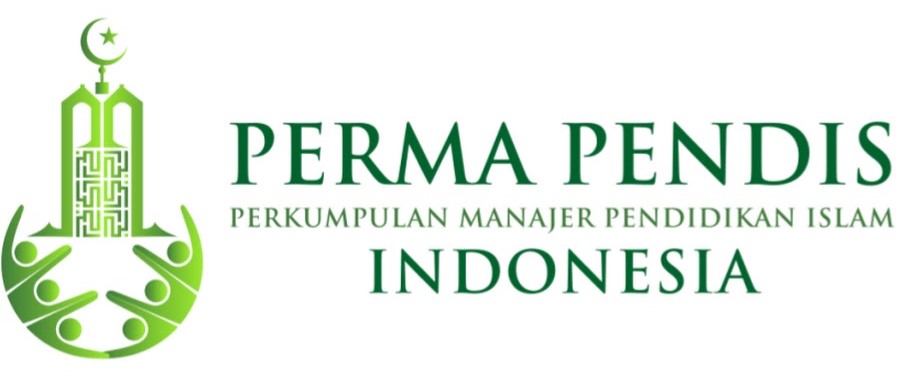Enhancing Distance Learning through Immersive Technologies: Integration of Augmented and Virtual Reality in Higher Education
DOI:
https://doi.org/10.35719/jier.v6i2.481Keywords:
Immersive Learning Experience, Augmented Reality, Virtual Reality, Distance LearningAbstract
This study investigates the integration of Augmented Reality (AR) and Virtual Reality (VR) in distance learning to enhance student engagement and comprehension in higher education. Employing a Research and Development (R&D) design guided by the ADDIE model, the research was conducted at four Indonesian universities. In the analysis stage, data were gathered from students and lecturers to identify learning challenges. Based on this, AR/VR-based modules were designed and implemented, particularly in zakat-related subjects. The results showed significant improvements in student motivation and understanding, with post-intervention test scores rising notably. Students experienced a more immersive and interactive environment, enabling flexible and context-rich learning. The study also highlights the importance of faculty training, infrastructure readiness, and continuous evaluation to ensure successful implementation. Findings support theories such as Dual Coding, Experiential Learning, and Constructivism, indicating that AR and VR can transform distance learning into more effective, inclusive, and student-centered experiences.
Penelitian ini mengkaji integrasi teknologi Augmented Reality (AR) dan Virtual Reality (VR) dalam pembelajaran jarak jauh untuk meningkatkan keterlibatan dan pemahaman mahasiswa di pendidikan tinggi. Menggunakan pendekatan Research and Development (R&D) dengan model ADDIE, studi ini dilakukan di empat perguruan tinggi Indonesia. Pada tahap analisis, data dikumpulkan dari mahasiswa dan dosen untuk mengidentifikasi tantangan belajar. Modul berbasis AR/VR dikembangkan dan diterapkan, khususnya pada materi zakat. Hasilnya menunjukkan peningkatan signifikan dalam motivasi dan pemahaman siswa, dengan skor tes pasca-intervensi yang meningkat. Teknologi ini menciptakan lingkungan belajar yang imersif dan interaktif, memungkinkan pembelajaran yang lebih fleksibel dan kontekstual. Studi ini juga menekankan pentingnya pelatihan dosen, kesiapan infrastruktur, dan evaluasi berkelanjutan untuk keberhasilan implementasi. Temuan mendukung teori Dual Coding, Pembelajaran Pengalaman, dan Konstruktivisme, menunjukkan bahwa AR dan VR dapat mentransformasi pembelajaran jarak jauh menjadi lebih efektif, inklusif, dan berpusat pada siswa.
Downloads
References
Asio, J. M. R., Gadia, E., Abarintos, E., Paguio, D., & Balce, M. (2021). Internet Connection and Learning Device Availability of College Students: Basis for Institutionalizing Flexible Learning in the New Normal. Studies in Humanities and Education, 2(1), 56–69. https://doi.org/10.48185/she.v2i1.224
Bisswang, N., Petrik, D., Heumüller, E., & Richter, S. (2024). What is Your VR Use Case for Educational Like: A State-Of-The-Art Taxonomy. Electronic Journal of E-Learning, 22(3), 46–62. https://doi.org/10.34190/ejel.21.6.3215
Buabeng-Andoh, C. (2012). Factors influencing teachers ’ adoption and integration of information and communication technology into teaching: A review of the literature. International Journal of Education and Development Using Information and Communication Technology, 8(1), 136–155. https://www.learntechlib.org/p/188018/
Cevahir, H., Özdemir, M., & Baturay, M. H. (2022). The Effect of Animation-Based Worked Examples Supported with Augmented Reality on the Academic Achievement, Attitude and Motivation of Students towards Learning Programming. Participatory Educational Research, 9(3), 226–247. https://doi.org/10.17275/per.22.63.9.3
Chand, S. P. (2023). Constructivism in Education: Exploring the Contributions of Piaget, Vygotsky, and Bruner. International Journal of Science and Research (IJSR), 12(7), 274–278. https://doi.org/10.21275/sr23630021800
De Back, T. T., Tinga, A. M., & Louwerse, M. M. (2023). Learning in immersed collaborative virtual environments: design and implementation. Interactive Learning Environments, 31(8), 5364–5382. https://doi.org/10.1080/10494820.2021.2006238
Dede, C. J., Jacobson, J., & Richards, J. (2017). Introduction: Virtual, augmented, and mixed realities in education (pp. 1-16). Springer Singapore. https://doi.org/10.1007/978-981-10-5490-7
Dunn, J. C., & Zimmer, C. (2020). Self-Determination Theory and the Facilitation of Intrinsic Motivation, Social Development, and Well-Being. Routledge Handbook of Adapted Physical Education, 55(1), 296–312. https://doi.org/10.4324/9780429052675-23
Familoni, B. and Onyebuchi, N. (2024). Augmented and virtual reality in U.S. education: A review: Analyzing the impact, effectiveness, and future prospects of AR/VR tools in enhancing learning experiences. International Journal of Applied Research in Social Sciences, 6(4), 642-663. https://doi.org/10.51594/ijarss.v6i4.1043
Garlinska, M., Osial, M., Proniewska, K., & Pregowska, A. (2023). The Influence of Emerging Technologies on Distance Education. Electronics (Switzerland), 12(7). https://doi.org/10.3390/electronics12071550
Guerra-Tamez, C. R. (2023). The Impact of Immersion through Virtual Reality in the Learning Experiences of Art and Design Students: The Mediating Effect of the Flow Experience. Education Sciences, 13(2). https://doi.org/10.3390/educsci13020185
Hakkarainen, P., & Bredikyte, M. (2008). The zone of proximal development in play and learning. Cultural-historical psychology, 4(4), 2-11. https://psyjournals.ru/journals/chp/archive/chp_2008_n4.pdf#page=2
Haleem, A., Javaid, M., Qadri, M. A., & Suman, R. (2022). Understanding the role of digital technologies in education: A review. Sustainable Operations and Computers, 3(1), 275–285. https://doi.org/10.1016/j.susoc.2022.05.004
Healey, M., & Jenkins, A. (2000). Kolb’s experiential learning theory and its application in geography in higher education. Journal of Geography, 99(5), 185–195. https://doi.org/10.1080/00221340008978967
Huang, L., & Musah, A. A. (2024). The influence of augmented reality on creativity, student behavior, and pedagogical strategies in technology-infused education management. Journal of Pedagogical Research, 8(2), 260–275. https://doi.org/10.33902/JPR.202425376
Jibril, J., & Çakir, H. (2023). Students’ Opinions on the Usage of Mobile Augmented Reality Application in Health Education. Journal of Learning and Teaching in Digital Age, 8(1), 10–24. https://doi.org/10.53850/joltida.1076286
Kaplan-Rakowski, R., & Gruber, A. (2023). The impact of high-immersion virtual reality on foreign language anxiety. Smart Learning Environments, 10(1), 1-18. https://doi.org/10.1186/s40561-023-00263-9
Kolb, D. A. (1984). Experiential Learning: Experience as The Source of Learning and Development. Prentice Hall, Inc., 1984, 20–38. https://doi.org/10.1016/B978-0-7506-7223-8.50017-4
Lai, A. F., Chen, C. H., & Lee, G. Y. (2019). An augmented reality-based learning approach to enhancing students’ science reading performances from the perspective of the cognitive load theory. British Journal of Educational Technology, 50(1), 232–247. https://doi.org/10.1111/bjet.12716
Li, R., Lund, A., & Nordsteien, A. (2023). The link between flipped and active learning: A scoping review. Teaching in Higher Education, 28(8), 1993–2027. https://doi.org/10.1080/13562517.2021.1943655
Loeng, S. (2020). Self-Directed Learning: A Core Concept in Adult Education. Education Research International, 2020, 1-12. https://doi.org/10.1155/2020/3816132
Mir, K. J., Fatima, S. A., & Fatima, S. T. (2023). Impact of Dual Coding Strategy to Enhance Students’ Retention of Scientific Concepts in Middle Schools. Annals of Human and Social Sciences, 4(4), 655-666. https://doi.org/10.35484/ahss.2023(4-iv)63
Papadopoulou, C., Karamatsouki, A., & Karagiannidis, C. (2022). Augmented Reality in Primary School Geography: Cognitive Goals and Usability. International Association for Development of the Information Society. 141–145. https://doi.org/10.33965/ice2022_202210c018
Putra, M. A., Erman, E., & Susiyawati, E. (2022). Students perception of augmented reality learning media on solar system topics. Jurnal Pijar Mipa, 17(5), 581–587. https://doi.org/10.29303/jpm.v17i5.3660
Radianti, J., Majchrzak, T. A., Fromm, J., & Wohlgenannt, I. (2020). A systematic review of immersive virtual reality applications for higher education: Design elements, lessons learned, and research agenda. Computers and Education, 147, 103778. https://doi.org/10.1016/j.compedu.2019.103778
Schmidt, D. A., Baran, E., Thompson, A. D., Mishra, P., Koehler, M. J., & Shin, T. S. (2009). Technological pedagogical content knowledge (TPACK) the development and validation of an assessment instrument for preservice teachers. Journal of research on Technology in Education, 42(2), 123-149. https://doi.org/10.1080/15391523.2009.10782544
Schwaiger, M., Krajn?an, M., Vukovi?, M., Jenko, M., & Doz, D. (2024). Educators’ opinions about vr/ar/xr: an exploratory study. Education and Information Technologies, 29(18), 24861-24880. https://doi.org/10.1007/s10639-024-12808-7
Shakeel, S. I., Al Mamun, M. A., & Haolader, M. F. A. (2023). Instructional design with ADDIE and rapid prototyping for blended learning: validation and its acceptance in the context of TVET Bangladesh. Education and Information Technologies, 28(6), 7601-7630. https://doi.org/10.1007/s10639-022-11471-0
Sharma, R., & Shukla, C. S. (2023). Constructivist approach in education: projecting the insights of Piaget and Vigotsky into future. International Journal of Research Cultures Society, 7(3), 79–84. https://ijrcs.org/wp-content/uploads/IJRCS202303016-min.pdf
Shevchuk, I., Filippova, L., Krasnova, A., & Bazyl, O. (2023). Virtual pedagogy: scenarios for future learning with VR and AR technologies. Futurity Education, 3(4), 95-117. https://doi.org/10.57125/fed.2023.12.25.06
Taggart, S., Roulston, S., Brown, M., Donlon, E., Cowan, P., Farrell, R., & Campbell, A. (2023). Virtual and augmented reality and pre-service teachers: Makers from muggles?. Australasian Journal of Educational Technology, 39(3), 1-16. https://doi.org/10.14742/ajet.8610
Talan, T., Yilmaz, Z. A., & Batdi, V. (2022). The Effects of Augmented Reality Applications on Secondary Students’ Academic Achievement in Science Course. Journal of Education in Science, Environment and Health, 11(1), 332–346. https://doi.org/10.55549/jeseh.1193695
Talbert, R., & Mor-Avi, A. (2019). A space for learning: An analysis of research on active learning spaces. Heliyon, 5(12), 1-19. https://doi.org/10.1016/j.heliyon.2019.e02967
Taqwa, T., & Raupu, S. (2022). Website-Based Academic Service Development with ADDIE Design in Higher Education. AL-ISHLAH: Jurnal Pendidikan, 14(2), 1511–1526. https://doi.org/10.35445/alishlah.v14i2.1323
Tene, T., Guevara, M., Moreano, G., Vera, J., & Gómez, C. (2024). The role of immersive virtual realities: enhancing science learning in higher education. Emerging Science Journal, 8(1), 88-102. https://doi.org/10.28991/esj-2024-sied1-06
Toni, M., & Sudin, M. (2024). Research and Development (R&D) Interactive Media That is Effective, Efficient and Fun for Students. Asian Journal of Social and Humanities, 2(6), 1239–1252. https://doi.org/10.59888/ajosh.v2i6.250
Yu, Y. H., Hu, Y. N., & Zhang, J. S. (2013). Vygotsky’s Zone of Proximal Development: Instructional Implications and Teachers’ Professional Development. Applied Mechanics and Materials, 411–414(4), 2952–2956. https://doi.org/10.4028/www.scientific.net/AMM.411-414.2952
Downloads
Published
How to Cite
Issue
Section
License
Copyright (c) 2025 Ahmad Shofiyuddin, Muttaqin Choiri, Firman Setiawan, Ahmad Farid Utsman, Ahmad Rifqi Azmi

This work is licensed under a Creative Commons Attribution-ShareAlike 4.0 International License.















